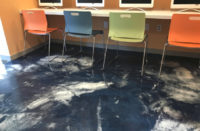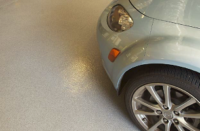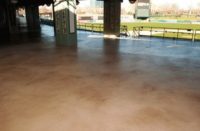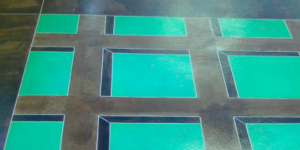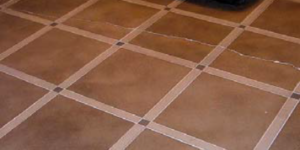
As the number of products available for concrete refinishing has multiplied in recent years, it has become increasingly simple to obtain almost any finish imaginable for concrete surfaces. Overlays are one of the many options. An overlay is a thin, permanent layer added to the top of a concrete slab to cover imperfections or add interest and beauty to a plain surface.
Overlays are popular with contractors, who are often hired to deal with a large, plain slab that the customer wants to be both attractive and durable. These surfaces usually need to be turned around on a tight timeline, which overlays allow.
While overlay products can be used to create almost any desired finish in a short timeline, the challenge lies in selecting the right type of overlay for your specific purpose. Cement-based overlays have been on the market for years, but they are only one of several types of overlay finishes. Most of today’s new products are made from a combination of polymer resins, cement, sand and other additives. These combinations improve the durability of the overlay surface and allow for a wider array of decorative finishes. Polymer overlays in particular adhere well to existing concrete, can be added in very thin or thick layers, and resist damage from the elements in most climates.
Manufacturers who create various combinations of acrylics and polymer resins for overlays end up developing proprietary products, each of which has its own specific characteristics.
Before determining which product is right for a particular project, it must first be determined if the concrete surface is worth fixing or if it should be replaced. The slab must be sound and not have severe damage to the structure or surface. Heavy damage to a slab resting on an unstable base will not be fixed by applying an overlay, and neither will severe spalling.

Self-leveling overlays are 1/4 inch to 1 inch in thickness, and texture can be added via engraving or saw cutting. Dyes can also be used with self-leveling overlays, as can integral pigments, tints and stains. Self-leveling overlays need to be applied to fundamentally sound concrete surfaces, but can be used to level uneven floors. Jeff Patterson of Muller Construction Supply in San Jose, Calif., says that stampable overlays are a popular product for his company. Stampable overlays are available in thicknesses from 1/4 inch to 3/4 inch and can be stamped just like new concrete. The thickness covers the original substrate, allowing imperfections to be permanently hidden. The color of the overlay can be incorporated via dye, colored liquid or powder, or by using a tinted sealer on top of the overlay.
Decorative acrylic overlays are popular because of their versatility, says Brian Anderson, director of operations with Concrete Coatings Inc. They can be used on new or existing concrete and can help create a wide array of looks, such as brick, tile, and other textures, for a fraction of the cost of the real thing. “Acid stains and decorative acrylic overlay systems are two of our most popular products,” he says.
 Charles Leland, director of training and product development at SureCrete Design Products, says spray coatings are has company’s most popular product due to their ease of application. Spray coatings create a thin film, are inexpensive compared to other systems, and have a short learning curve, allowing anyone to try them at least once. Leland also joins Patterson and Anderson in saying that stamp overlays are very popular. They may not be as easy to apply, he says, but they give a beautiful look that can’t be achieved any other way.
Charles Leland, director of training and product development at SureCrete Design Products, says spray coatings are has company’s most popular product due to their ease of application. Spray coatings create a thin film, are inexpensive compared to other systems, and have a short learning curve, allowing anyone to try them at least once. Leland also joins Patterson and Anderson in saying that stamp overlays are very popular. They may not be as easy to apply, he says, but they give a beautiful look that can’t be achieved any other way.
Newer options on the overlay market combine versatility and ease of application for an all-around innovative product. GST International LLC of Santa Rosa, Calif., makes Ultracrete2K, a stampable, trowelable overlay that goes on top of almost any surface. “We wanted it easy and user-friendly and wanted it to go over every surface tile counters, showers, anything,” says GST International owner Jim Glessner. While most overlays require waiting for a surface to firm up before stamping, this one allows stamping immediately, saving time and labor costs.
Leland says that while weather and climate shouldn’t be an influence on which products are their bestsellers, they are. Spray coatings and stamp overlays, SureCrete’s most popular products, perform well in any conditions, but sell best in the Sunbelt. “People don’t believe (they’ll) work in freeze-thaw conditions, even though (they) will,” he says. “The temperature swing is the most important factor, which is why they test them in Miami it could be 98 degrees and fall to 40 degrees at night. That is worse than in Iowa, where it could be 2 below zero and go up to 10 degrees.”

While Leland says climate isn’t much of a factor, since the elements don’t affect the finishes, he says there are still regional differences in what products are used. This is due mostly to what he calls “acceptance”- product popularity and trends spread across the country. Some types of overlays are popular in certain parts of the country, but just haven’t spread to others yet.
Certain kinds of overlays are also in demand for specific applications. For example, acrylic overlays can be more popular outdoors because of their texture. Sprayed applications that create a finish similar to an orange peel are also popular around pools and for sidewalks because they offer traction.
Leland says SureCrete is constantly developing new products and tweaking the old standbys, creating products that, in addition to being easier to apply and less expensive, now work in situations where they never would have in the past.
Regardless of what overlays are popular and why, learning about the array of overlay products available and what will best create the desired appearance is a task that takes time and dedication.
